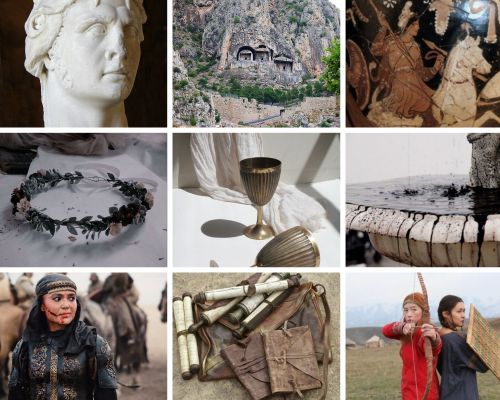#mithridates
Me: O King ;), either strive to be stronger ;) than Rome ;), or do her bidding ;) without a word ;););)
Hypsicratea - Warrior queen of Pontus
Between 88 BCE and 63 BCE, king Mithridates IV ofPontus, in present-day Turkey, fought against the Roman Empire. One of his most stalwart companions was the warrior woman Hypsicratea.
According to Roman writer Valerius Maximus, Hypsicratea was Mithridates’ official wife. Out of love for her husband she:
“(…)was happy to trade her splendid beauty for a masculine style, for she cut her hair and accustomed herself to riding horses and using weapons so that she could participate in the king’s toils and share his dangers. Indeed, when Mithradates was cruelly defeated by [the Roman general] Pompey and fleeing through the lands of wild peoples, Hypsicratea was his unflagging companion in body and soul. For Mithradates, her extraordinary fidelity was his greatest solace and most pleasant comfort in those bitter times and hardships. He considered that even while he was wandering in adversity he was always at home because Hypsicratea was in exile along with him.”
Plutarch gives a slightly more different version of her story. According to him, Hypsicratea was a concubine. She “rode a Persian steed and was dressed and armed like a Persian man. She never tired of rough riding and combat”and cared for Mithridates’ horse. The king apparently liked to call her by the masculine version of her name, Hypsicrates, because of her daring disposition.
Hypsicratea’s existence and rank are confirmed by archeology. An ancient Greek inscription recovered from the Sea of Azovsays: “Hypsicrates, wife of Mithradates Eupator. Love and Respect”. Which means that she was indeed his wife and not a concubine.
It’s likely that Hypsicratea joined Mithridates’ cavalry around 68-67 BCE. Indeed, the king recruited many fighters from the nomad tribes of Armenia, Colchis, Caucasia, and the Caspian Sea region. Some of these warriors were female, so Hypsicratea may have been one of them. Or maybe she was among the fighters for Thermodon who joined Mithridates’ army in 67 BCE.
In 67 BCE, Hypsicratea contributed to Mithridates’ victory at Zela. She was by his side when Pompeyattacked his camp in 66 BCE. Mithridates charged at the Romans with his horsemen, but they were soon dispersed and he found himself with three companions, including Hypsicratea, left. They endured a long winter march and were finally sheltered by neighboring tribes.
In the meantime, the Romans were attacked by hostile tribes on the borderland of Iberia and Albania (near Tbilisi, Georgia). Among them were reportedly warrior women since Appian wrote that Pompey’s soldiers discovered “many women”on the battlefield and among the prisoners and that “the women’s wounds showed that they had fought as vigorously and courageously as the men”. Graves of warrior women were indeed excavated in this area.
Mithridates and Hypsicratea survived this dangerous journey and Mithridates’ regained his throne. In 63 BCE, a revolt led by his son allied with Pompey forced him to commit suicide. Hypsicratea’s fate remains mysterious, but she may have survived. Indeed, her name was extremely rare and there were only two occurrences of it, the two being contemporary. The first was the queen herself, and the other a shadowy prisoner of war named Hypsicrates. This Hypsicrates was a war prisoner freed by Julius Caesar in Pontus in 47 BCE and later served him as an historian. This person was reportedly an expert on two subjects: fortifications of the Borporan Kingdom and the Amazons of the Caucasus region. Could this Hypsicrates be, in fact, Hypsicratea? If this was the case, she would have lived up to 92 years old.
Bibliography:
Mayor Adrienne, The Amazons, Lives and Legends of Warrior Women across the Ancient World
Plutarch, Parallel Lives
Post link

